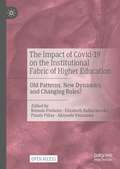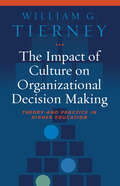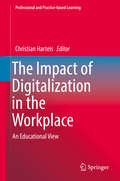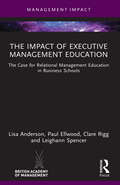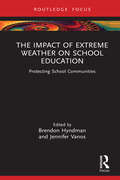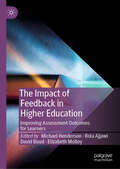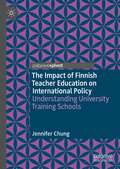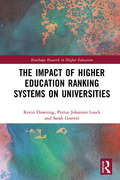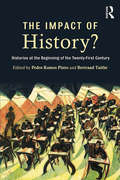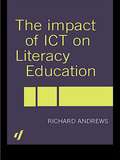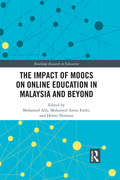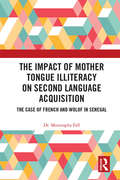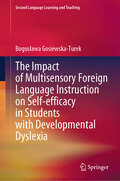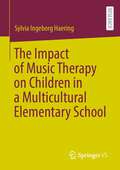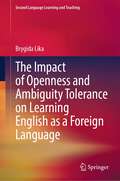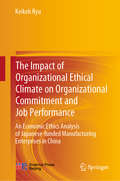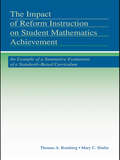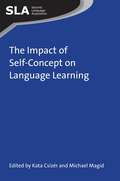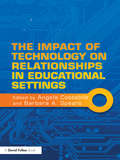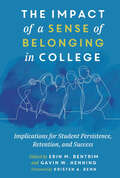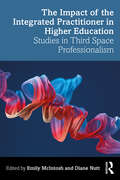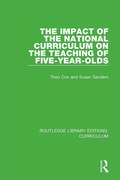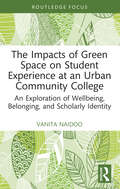- Table View
- List View
The Impact of Covid-19 on the Institutional Fabric of Higher Education: Old Patterns, New Dynamics, and Changing Rules?
by Rómulo Pinheiro Akiyoshi Yonezawa Pundy Pillay Elizabeth BalbachevskyThis open access book assesses how the Covid-19 pandemic caught higher education systems throughout the world by surprise. It maps out the responses of higher education institutions to the challenges and strategic opportunities brought about by the pandemic, and examines the effects such responses may have. Bringing together scholars and case studies from Europe, Asia, Africa and the Americas, the book is both comparative and global in nature. It also brings together researchers from a variety of disciplinary fields, including political scientists, historians, economists, sociologist, and anthropologists. In doing so, the book fosters an inter-disciplinary dialogue and inclusive methodological approach for unpacking the complexities associated with modern higher education systems and institutions.
The Impact of Culture on Organizational Decision-Making: Theory and Practice in Higher Education
by William G. TierneyColleges and universities are currently undergoing the most significant challenges they have faced since World War II. Rising costs, increased competition from for-profit providers, the impact of technology, and the changing desires and needs of consumers have combined to create a dynamic tension for those who work in, and study, postsecondary education. What worked yesterday is unlikely to work tomorrow. The status quo or bromides such as “stay the course” are insufficient responses in a market that demands creativity and innovation if an organization does not simply wish to survive, but thrive.Managerial responses or top-down linear decisions are antithetical to academic organizations and most likely recipes for disaster. In today’s “flat world”, decision-making for most organizations has become less hierarchical and more decentralized. Understanding this trend is of particular importance for organizations with traditions of shared governance. The message of this book is that understanding organizational culture is critical for those who recognize that academe must change, but are unsure how to make that change happen. Even the most seasoned college and university administrators and professors often ask themselves, “What holds this place together?” The author’s answer is that an organization’s culture is the glue of academic life. Paradoxically, this “glue” does not make things get stuck, but unstuck. An understanding of culture enables an organization’s participants to interpret the institution to themselves and others, and in consequence, to propel the institution forward.An organization’s culture is reflected in what is done, how it is done, and who is involved in doing it. It concerns decisions, actions, and communication on an instrumental and symbolic level. This book considers various facets of academic culture, discusses how to study it, how to analyze it, and how to improve it in order to move colleges and universities aggressively into the future while maintaining core academic values. This book presents updated versions of eight key articles on organizational culture in higher education by William G. Tierney. The new introduction that sets them in the context of current and future challenges will add further value to articles that are already in high demand.
The Impact of Digitalization in the Workplace: An Educational View (Professional and Practice-based Learning #21)
by Christian HarteisThis edited volume brings together researchers from various disciplines (i.e. education, psychology, sociology, economy, information technology, engineering) discussing elementary changes at workplaces occurring through digitalization, and reflecting on educational challenges for individuals, organizations, and society. The latest developments in information and communication technology seem to open new potential, and the crucial question arises which kind of work can be replaced by technology? The contributors to this volume are scholars who have been conducting research on the influence of technological change on work and individuals for a long time. The book addresses researchers as well as practitioners in the field of adult education and human resource development.
The Impact of Executive Management Education: The Case for Relational Management Education in Business Schools (Management Impact)
by Lisa Anderson Clare Rigg Leighann Spencer Paul EllwoodThis book contributes to the debate about the impact of business and management schools.It brings together work that has been carried out over the last few years, to call attention to the idea that the impact of academics is not solely achieved through their research and engagement activities, and that their teaching has the potential to change management practice and thinking. As business school academics, the authors are in the privileged position of educating the managers of the future, whose work will influence the lives of many others, both on a day-to-day basis within their organisations and in a much broader, societal way. They propose relational management education (RME) as an approach that supports managers to learn and develop as ethical and collegial scholar-practitioners. They also introduce models which can help conceptualise pedagogies for impact and examples of student learning journeys showing how this approach can be enacted.The book will be of interest to academics in business and management schools at any career stage. It will also appeal to university and business school leaders and policymakers seeking to extend their understanding of the power and potential of education to achieve impact.
The Impact of Extreme Weather on School Education: Protecting School Communities
by Brendon Hyndman Jennifer VanosThis book introduces an emerging area of research exploring the influence of extreme weather events on school systems. Chapters explore a range of extreme weather events such as snowstorms, bushfires, extreme winds, heavy rainfall and prolonged heat waves, and their potentially widespread impacts. It also covers key challenges faced by schools, including how to protect students, levels of teacher preparation to counter extreme weather conditions and how students' learning is impacted by extreme weather patterns. Drawing on a broad range of research in this field, this book will appeal to environmental and educational researchers, as well as those currently studying or practising in education.
The Impact of Feedback in Higher Education: Improving Assessment Outcomes for Learners
by Michael Henderson David Boud Rola Ajjawi Elizabeth MolloyThis book asks how we might conceptualise, design for and evaluate the impact of feedback in higher education. Ultimately, the purpose of feedback is to improve what students can do: therefore, effective feedback must have impact. Students need to be actively engaged in seeking, sense-making and acting upon any information provided to them in order to develop and improve. Feedback can thus be understood as not just the giving of information, but as a complex process integral to teaching and learning in which both teachers and students have an important role to play. The editors challenge us to ask two fundamental questions: when does feedback make a difference, and how can we recognise that impact? This volume draws together leading international researchers across diverse disciplines, offering promising directions for both research and practice.
The Impact of Finnish Teacher Education on International Policy: Understanding University Training Schools
by Jennifer ChungThis book explores the partnership between Finnish universities and the university-affiliated teacher training schools known as 'normal schools'. It examines the benefits of school-based learning combined with Master’s-level teacher education, uncovering the advantages of this unique school-university partnership. This book also explores the possibility of Finnish teacher education, and more specifically, the normaalikoulu, and its potential as an international export product. Although policy borrowing theory has long warned about the difficulties in successful transfer, interest in Finnish teacher education continues to rise. Therefore, this book investigates, in depth, the historical, cultural, and current context of Finnish teacher education and the normal schools, and the potential to move this policy abroad.
The Impact of Higher Education Ranking Systems on Universities (Routledge Research in Higher Education)
by Sarah Gravett Kevin Downing Petrus Johannes LoockThis book, written by three generations of rankings academics with considerable experience from three very different regions of the globe, lifts the lid on the real impact of higher education ranking systems (HERS) on universities and their stakeholders. It critically analyses the criteria that make up the ‘Big Three’ global ranking systems and, using interviews with senior administrators, academics and managers, discusses their impact on universities from four very different continents. Higher education continues to be dominated by a reputational hierarchy of institutions that sustains and is reinforced by HERS. Despite all the opinions and arguments about the legitimacy of the rankings as a construct, it seems experts agree that they are here to stay. The question, therefore, seems to be less about whether or not universities should be compared and ranked, but the manner in which this is undertaken. Delivering a fresh perspective on global rankings, this book summarizes the development of HERS and provides a critical evaluation of the effects of HERS on four different major regions – South Africa, the Arab region, South East Asia, and Australia. It will appeal to any academic, student, university administrator or governing body interested in or affected by global higher education ranking systems.
The Impact of History?: Histories at the Beginning of the 21st Century
by Bertrand Taithe Pedro Ramos PintoDriven by the increasing importance of discussions around 'impact' and its meaning and implications for history, The Impact of History? brings together established and new voices to raise relevant questions, issues and controversies for debate. The chapters are articulated around the themes of public history, the politics of history, the role of history in the shaping of learning and the situation of history in the changing world of education. While this subject is driven differently by the research bodies and councils of different countries, similar debates about the value and place of the academy in society are taking place in the UK, the USA and Europe as well as in other parts of the world. Chapters cover diverse areas of history from this perspective including: public history national histories new technologies and the natural sciences campaigning histories the impact agenda. This collection is a political and intellectual intervention at a time when scholars and readers of history are being asked to explain why history matters and it seeks to intervene in the debates on ‘impact’, on education and on the role of the past in the shaping of our future. Bringing together leading authors from a wide range of fields, The Impact of History? is an accessible and engaging yet polemical and thought-provoking overview of the role of history in contemporary society.
The Impact of ICT on Literacy Education
by Richard AndrewsThis authoritative landmark text examines the highly topical and important issue of ICT in literacy learning. Its distinctive focus on providing a systematic review of research in the field gives the reader an essential, comprehensive overview. As governments worldwide continue to invest heavily in ICT provisions in educational institutions, this book addresses the need to gather and synthesise evidence about the impact of ICT on literacy learning. An expert team of writers draw upon two recent reports by the Organisation for Economic Co-Operation and Development, which highlighted the considerable differences between nations in the access and use of ICT, to take a discursive and expansive look at the subject. Within its wide range and scope, chapters cover areas on: * the history of literacy and ICT* evidence for the effectiveness of ICT on literacy learning* the impact of networked ICT on literacy learning* the relationship between verbal and visual literacies. This book will be an invaluable and informative read with international resonance for student teachers, teachers, academics and researchers worldwide.
The Impact of MOOCs on Distance Education in Malaysia and Beyond (Routledge Research in Education #38)
by Mohamed Ally Mohamed Amin Embi Helmi NormanThis book provides theoretical and empirical discussions around the impact of MOOCs and other pedagogical strategies for online learning in international contexts. Through discussions of inverse blended learning and other teaching and learning approaches, Part I navigates the pressing conceptual issues around global online education. By analyzing the Malaysia MOOC Initiative—the first governmental MOOC project in the world—Part II offers insight into the developmental strategies, learning design, and integrative approaches of these pioneering efforts. Edited by leading scholars in the field of globalized online learning, this volume offers a valuable contribution to research around collaborative initiatives between governments and universities, especially ones dedicated to open and distance education.
The Impact of Mother Tongue Illiteracy on Second Language Acquisition: The Case of French and Wolof in Senegal (Routledge Research in Language Education)
by Moustapha FallThis text illustrates the crucial role of the mother tongue literacy in second language acquisition by presenting findings from a comparative study conducted in primary schools in Senegal. In addition, the volume provides an in-depth look at the linguistic history of Senegal before, during, and after French colonialism. The Impact of Mother Tongue Illiteracy on Second Language Acquisition discusses the socio-linguistic landscape and ethnolinguistic composition of Senegal and its effect on the second language acquisition. An in-depth analysis of children’s phonological awareness, decoding, and reading comprehension in French reveals significant disparities in the literacy skills of Wolof children who have been exposed to Arabic and Qur’anic texts prior to schooling, and those who have not. In doing so, the text explores the impacts of post-colonial language policies in Africa, highlights the pedagogical consequences of mother tongue illiteracy, and questions the use of French as the only language of instruction in Senegalese schools. This detailed research text will of great interest and use to graduate and postgraduate students, researchers, academics, professionals and policy makers in the field of Second Language Acquisition, Multicultural Education, Applied Linguistics, French language education and, Language Policy and Planning.
The Impact of Multisensory Foreign Language Instruction on Self-efficacy in Students with Developmental Dyslexia (Second Language Learning and Teaching)
by Bogusława Gosiewska-TurekThis book investigates the effect of multisensory instruction on self-efficacy among students with developmental dyslexia learning English as a foreign language. The first three chapters of the book delve into theoretical aspects of developmental dyslexia, multisensory instruction, and self-efficacy, providing an overview of existing research in this domain. The second part of the book reports empirical findings obtained from a case study supplemented by quantitative analysis. These findings highlight the advantages of employing multisensory instructional techniques for teaching foreign languages to students with dyslexia. Notably, the application of multisensory instruction not only enhances dyslexic students’ foreign language competencies but also positively impacts their self-efficacy. The study underscores the importance of language instruction tailored to the special educational needs of students with dyslexia as well as its potential to foster self-efficacy, an essential factor for success in foreign language learning.
The Impact of Music Therapy on Children in a Multicultural Elementary School
by Sylvia Ingeborg HaeringThe OECD stated in 2018 that language barriers are among the greatest obstacles to the successful inclusion of students with an immigrant background. Providing adequate instruction in the language of instruction at school, and offering learning experiences independent of the level of language skills is, therefore, an essential task of the 21st-century school systems. This book explores how music therapy can contribute to solving this challenge. It investigates the multicultural learning environment of an Italian elementary school that is characterised by students with multiple native languages and different levels of proficiency in the language of instruction. In some cases, students have difficulty following lessons and participating in social life. The children (5-8 years) receive music therapy in the experimental condition and regular school activity in the control condition according to a within-subject control group design, meaning that half the children started in the control condition and the other started in the experimental condition; they switched at the half-time point. Data on the children’s language skills and general behaviour are collected and analysed.
The Impact of Openness and Ambiguity Tolerance on Learning English as a Foreign Language (Second Language Learning and Teaching)
by Brygida LikaThis book highlights the importance of individual learner differences in learning English as a foreign language and reports the findings of a study which investigated the impact of two personality traits, which are, openness to experience and ambiguity tolerance, on target language attainment among Polish secondary school students. The book provides an exhaustive overview of the theoretical issues and existing research related to personality, emphasizing the two traits under investigation, openness, and ambiguity tolerance, which are the focus of the empirical study reported later in the book. The empirical investigation explored relationships between openness to experience and ambiguity tolerance, as well as their impact on attainment in learning English as a foreign language. Moreover, it also aimed to shed light on the link between these traits and students’ assessments (i.e., self-assessment and school grades). The findings of the study provide a basis for proposing specific profiles of foreign language learners with different levels of openness and ambiguity tolerance.
The Impact of Organizational Ethical Climate on Organizational Commitment and Job Performance: An Economic Ethics Analysis of Japanese-funded Manufacturing Enterprises in China
by Keikoh RyuThis study seeks to evaluate the impact of organizational ethical climate on the organizational commitment and job performance of Japanese-funded manufacturing enterprises (JFMEs) in China using empirical analysis and discussion, and includes a review of related research into economic ethics as well as a quantitative analysis of the various types of organizational ethical climates typically found in JFMEs operating in China. While prior studies have approached the topic from an ethical, psychological, philosophical and/or sociological perspective, none have specifically analyzed organizational ethical climate and its effect on organizational commitment and job performance under these conditions. Nor has an analysis of the relationship between organizational ethical climate, organizational commitment, and job performance ever been approached from the perspective of economic ethics. This study illustrates the feasibility of researching organizational ethics from an economic perspective, while laying out a theoretical basis for exploring the philosophy of economics from the perspective of economic ethics.
The Impact of Reform Instruction on Student Mathematics Achievement: An Example of a Summative Evaluation of a Standards-Based Curriculum (Studies in Mathematical Thinking and Learning Series)
by Thomas A. Romberg Mary C. ShaferSummarizing data derived from a four-year combined longitudinal/ cross-sectional comparative study of the implementation of one standards-based middle school curriculum program, Mathematics in Context, this book demonstrates the challenges of conducting comparative longitudinal research in the reality of school life. The study was designed to answer three questions: What is the impact on student performance of the Mathematics in Context instructional approach, which differs from most conventional mathematics texts in both content and expected pedagogy? How is this impact different from that of traditional instruction on student performance? What variables associated with classroom instruction account for variation in student performance? The researchers examined a range of variables that affected data collection. These variations highlight the need to study the effects of the culture in which student learning is situated when analyzing the impact of standards-based curricula on student achievement. This book is directed to educational researchers interested in curriculum implementation, mathematics educators interested in the effects of using reform curriculum materials in classrooms, evaluators and research methodologists interested in structural modeling and scaling of instructional variables, and educational policy makers concerned about reform efforts.
The Impact of Self-Concept on Language Learning
by Kata Csizér Michael MagidThis edited volume seeks to highlight the effects of self-concept on L2 learning and teaching by considering a wide range of theories as well as their practical application. The book is divided into four sections and includes: chapters discussing various approaches related to self-concept; empirical studies related to the selves of the learners; research from teachers' perspectives on students' self-concept; and L2 motivational intervention studies associated with the development of self-concept of language learners. The volume contains a collection of studies from around the world (Central Europe, Canada, Asia and Australia) which were carried out using a variety of research methods and have a range of foci including adult and young learners, public and private education, foreign and second language settings, and teacher and learner motivation.
The Impact of Technology on Relationships in Educational Settings
by Barbara A. Spears Angela CostabileAs the linguistic, cognitive and social elements of our lives are transformed by new and emerging technologies, educational settings are also challenged to respond to the issues that have arisen as a consequence. This book focuses on that challenge: using psychological theory as a lens to highlight the positive uses of new technologies in relationships and educational settings, and to advocate technological learning opportunities and social support where the misuse and abuse of ICT occurs. The Impact of Technology on Relationships in Educational Settings sets out to explore the role of ICTs in relationship forming, social networking and social relationships within our schools and has grown out of the European Cooperation in Science and Technology (COST); Action on cyberbullying, involving 28 participating countries, and two non-COST countries, of which Australia is one. This cutting edge international text offers cross-cultural, psychological perspectives on the positive uses of new and emerging technologies to improve social relationships and examples of best practice to prevent virtual bullying. This comes at a time when much of the focus in current writings has been on the more negative aspects which have emerged as new technologies evolved: cyberbullying, cyber-aggression and cybersafety concerns. This text is ideally suited to researchers and practiitioners in the fields of Educational and developmental psychology, as well as those specialising in educational technology and the sociology of education.
The Impact of a Sense of Belonging in College: Implications for Student Persistence, Retention, and Success
by Kristen A. Renn Gavin W. Henning Erin M. BentrimSense of belonging refers to the extent a student feels included, accepted, valued, and supported on their campus. The developmental process of belonging is interwoven with the social identity development of diverse college students. Moreover, belonging is influenced by the campus environment, relationships, and involvement opportunities as well as a need to master the student role and achieve academic success. Although the construct of sense of belonging is complex and multilayered, a consistent theme across the chapters in this book is that the relationship between sense of belonging and intersectionality of identity cannot be ignored, and must be integrated into any approach to fostering belonging.Over the last 10 years, colleges and universities have started grappling with the notion that their approaches to maintaining and increasing student retention, persistence, and graduation rates were no longer working. As focus shifted to uncovering barriers to student success while concurrently recognizing student success as more than solely academic factors, the term “student sense of belonging” gained traction in both academic and co-curricular settings. The editors noticed the lack of a consistent definition, or an overarching theoretical approach, as well as a struggle to connect disparate research. A compendium of research, applications, and approaches to sense of belonging did not exist, so they brought this book into being to serve as a single point of reference in an emerging and promising field of study.
The Impact of a Sense of Belonging in College: Implications for Student Persistence, Retention, and Success
by Erin M. Bentrim, Gavin W. Henning, Kristen A. RennSense of belonging refers to the extent a student feels included, accepted, valued, and supported on their campus. The developmental process of belonging is interwoven with the social identity development of diverse college students. Moreover, belonging is influenced by the campus environment, relationships, and involvement opportunities as well as a need to master the student role and achieve academic success. Although the construct of sense of belonging is complex and multilayered, a consistent theme across the chapters in this book is that the relationship between sense of belonging and intersectionality of identity cannot be ignored, and must be integrated into any approach to fostering belonging.Over the last 10 years, colleges and universities have started grappling with the notion that their approaches to maintaining and increasing student retention, persistence, and graduation rates were no longer working. As focus shifted to uncovering barriers to student success while concurrently recognizing student success as more than solely academic factors, the term “student sense of belonging” gained traction in both academic and co-curricular settings. The editors noticed the lack of a consistent definition, or an overarching theoretical approach, as well as a struggle to connect disparate research. A compendium of research, applications, and approaches to sense of belonging did not exist, so they brought this book into being to serve as a single point of reference in an emerging and promising field of study.
The Impact of the First World War on British Universities: Emerging from the Shadows
by John TaylorThe First World War had innumerable consequences for all aspects of society; universities and education being no exception. This book details the myriad impacts of the war on British universities: telling how universities survived the war, their contribution to the war effort and the changes that the war itself brought about. In doing so, the author highlights the changing relationship between universities and government: arguing that a transformation took place during these years, that saw universities moving from a relatively closed world pre-1914 to a more active and open role within the national economy and society. The author makes extensive use of original documentary material to paint a vivid picture of the experiences of British universities during the war years, combining academic analysis with contemporary accounts and descriptions. This uniquely researched book will appeal to students and scholars of the history of higher education, social history and the First World War.
The Impact of the Integrated Practitioner in Higher Education: Studies in Third Space Professionalism
by Emily McIntoshThe Impact of the Integrated Practitioner in Higher Education highlights the importance of developing blended professionalism as a way of future-proofing Higher Education leadership, strategy, and outcomes. With carefully chosen international contributors, this book discusses the rationale for championing blended/integrated practitioners and uses a narrative case study approach to uncover the value, identities, and impact of these individuals who work across institutional boundaries, to promote interdisciplinarity as well as staff and student success. Divided into four key sections, this book explores: strategies, leadership, and theory; identities, boundaries, and ways of working; the impact of blended professionals/integrated practitioners; career trajectories and developing the integrated practitioner. The Impact of the Integrated Practitioner in Higher Education is a must-read for anyone interested in the future of higher education, including academic and professional staff, as well as postgraduate students in the field of Education.
The Impact of the National Curriculum on the Teaching of Five-Year-Olds (Routledge Library Editions: Curriculum #3)
by Susan Sanders Theo CoxOriginally published in 1994. One of the most neglected areas of research and thus writing is the world of the infant school child. Those who know it best are teachers who tend not to write. Those who write most are academics and even they venture rarely into this area. This book is based on research funded by the University of Wales. A number of teachers in a Welsh LEA were interviewed over time as the National Curriculum was being introduced up to Key Stage 1. The structured interviews covered a wide range of topics related to the anticipated and actual efforts of the National Curriculum at this key stage including curriculum planning, assessment, teaching methods, and organization. Teachers' attitudes to the curriculum were explored through a short attitude test. The resulting data provides in depth the first such examination and is a resource not only in itself but for all those researchers on change agents and restructuring.
The Impacts of Green Space on Student Experience at an Urban Community College: An Exploration of Wellbeing, Belonging, and Scholarly Identity (Routledge Research in Higher Education)
by Vanita NaidooThis book presents a rich case study examining physical and spatial factors of urban campus design that influence student experience and wellbeing. The text details important historical context illustrating the foundational concepts and purpose of college sites in the United States and maps economic reforms and policies which have driven the development of today’s inner-city campuses. Focusing on Bronx Community College, New York, and looking specifically at how the presence or absence of green space impacts students, the text then draws on diverse student voices to examine how students use open spaces, and how this influences their sense of belonging, stress reduction, and scholarly identities. The author’s historical and qualitative research presents original insights and relies on a rich body of textual and on-site investigation. This book will be a valuable resource for researchers and academics with an interest in urban education and higher education. It will be of particular interest to those with a focus on multicultural education and education policy.
